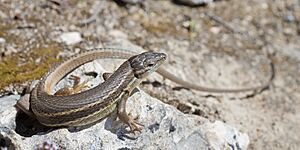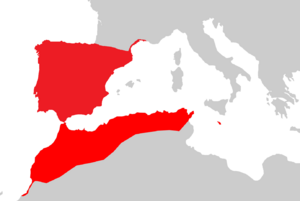Psammodromus algirus facts for kids
Quick facts for kids Psammodromus algirus |
|
|---|---|
 |
|
| Conservation status | |
| Scientific classification | |
 |
|
| Range | |
| Synonyms | |
|
The Psammodromus algirus, also known as the Algerian psammodromus, is a type of lizard. It belongs to the Lacertidae family, which includes many common lizards. You can find this lizard in parts of southwestern Europe and northwestern Africa.
Contents
Meet the Algerian Psammodromus
This lizard is often called the Algerian psammodromus. It's a fascinating reptile that lives in warm, sunny places.
Different Types of Algerian Psammodromus
Scientists have found four main types, or subspecies, of the Algerian psammodromus. They are:
- Psammodromus algirus algirus (Linnaeus, 1758)
- Psammodromus algirus doriae Bedriaga, 1886
- Psammodromus algirus nollii Fischer, 1887
- Psammodromus algirus ketamensis Galán, 1931
Sometimes, scientists group these lizards differently. For example, some think that Psammodromus algirus nollii and Psammodromus algirus ketamensis might be their own separate species.
Where These Lizards Live
The Algerian psammodromus lives in two main areas. You can find them in North Africa, including Morocco, Algeria, and Tunisia. They also live in southwestern Europe, specifically in the Iberian Peninsula (which includes Portugal, Spain, Andorra, and Gibraltar). You might also spot them in the very south of France and near Lampedusa in Italy.
What Their Home Looks Like
These lizards usually prefer places with lots of dense, bushy plants. This gives them good places to hide and hunt. However, they can also be seen in more open areas. They can live high up in mountains, sometimes as high as 2,600 m (8,500 ft) above sea level. But they are more commonly found in lower areas.
What the Algerian Psammodromus Eats
The Algerian psammodromus mainly eats small creatures that live on the ground. These are mostly arthropods, which include insects and spiders. Some of their favorite foods are:
- Grasshoppers and crickets (Orthoptera)
- Ants (Formicidae)
- Beetles (Coleoptera)
- True bugs (Hemiptera)
- Spiders (Araneae)
Protecting This Lizard
The Algerian psammodromus is currently listed as a species of "least concern" by conservation groups. However, it faces a threat from habitat loss. This means that the places where they live are being destroyed or changed, which can make it harder for them to survive. It's important to protect their homes so these lizards can continue to thrive.
How to Spot One
The Algerian psammodromus is a medium-sized lizard. Its body, from its snout to the base of its tail, is usually about 7.5 cm (3.0 in) long. Some can grow a bit larger, up to 9 cm (3.5 in). Its tail is quite long, about 2 to 3 times the length of its body! Their back is usually a shiny brownish color. They also have two clear white or yellowish stripes running along each side of their body.


